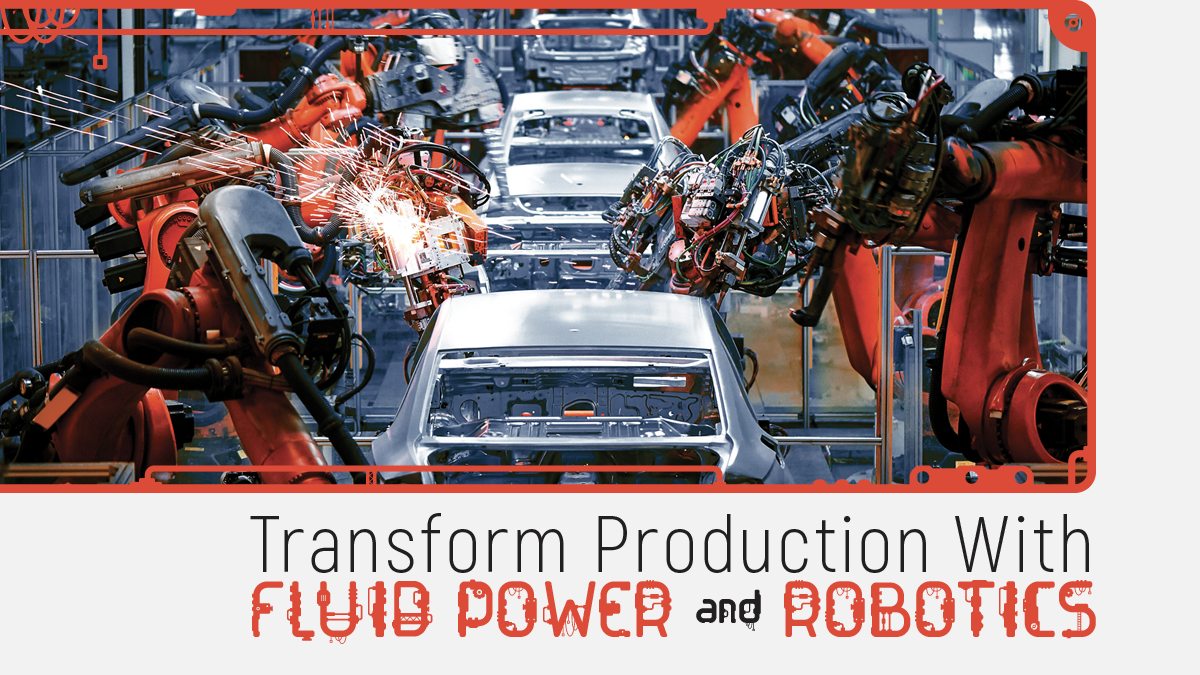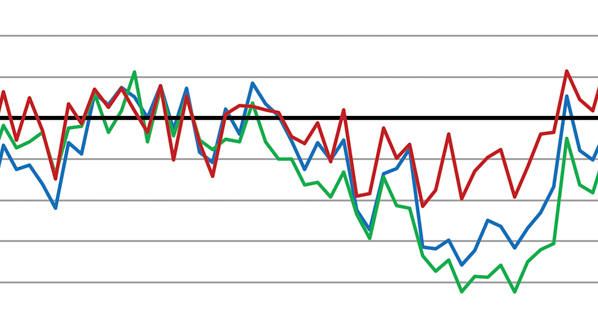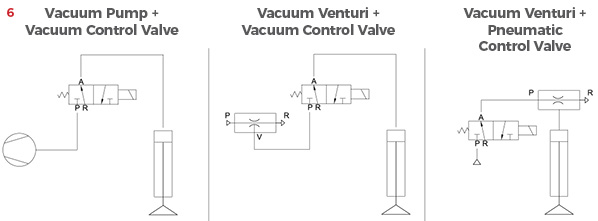Transform Production With Fluid Power and Robotics

High-performance fluid power components can help improve efficiency and quality, reduce waste and energy consumption, as well as increase safety.
By Sumit Kapde, Global Business Development Manager, Robotics and Proportional Valves.
From improving efficiency and quality to reducing energy consumption to optimizing a skilled workforce, manufacturers are increasingly challenged by a confluence of pressures. One solution that manufacturers rely on to help meet these challenges is robotics. In the automotive industry alone, manufacturers have more than one million robots in operation, more than any other industry.1
Robots play a critical role in transforming the factory floor, and one element is particularly important: end-of-arm tooling. These components, placed at the end of a robotic arm, interact with the product or product elements to enable the robot to perform tasks, such as welding, painting or gripping. When combined with pneumatic power systems, end-of-arm tooling is key to making robotics effective factory automation tools.
Pneumatic solutions, which use power to generate motion and control various forms of media, are particularly well suited for a wide range of industrial applications, from force control and assembling to handling and cutting tasks. Operators use pneumatics to control air or gases at higher precision and speed. These solutions also offer high power density, reliability and robustness — all while supporting the need for improved efficiency, reduced waste and consumption — and they often provide a smaller footprint.
Working as part of the robotic system, pneumatic components help the operator perform tasks reliably, as well as more quickly and more efficiently. Pneumatic systems can also integrate with various safety systems to enhance safe operation in tough environments, or when in use near workers.
Improving efficiency and quality
Manufacturers using paint robots in manufacturing and automotive industries are challenged to create consistencies in paint spray, as well as faster reaction times for flow and pressure changes in a paint robot’s atomizers. These measures can avoid the overspray of paint media and reduce the paint sludge generation.
In a paint sprayer, the paint’s flow must be controlled via a closed-loop monitoring system that can adjust the valve. A high-performance proportional valve, a type of solenoid valve that changes output values in proportion to input, can enhance efficiency by providing fast response and consistent control.
For example, one type of regulator that is designed for the paint robot application has a response time of below 80 milliseconds for a flow or pressure change. Customized solutions can add even more control, for example, with an external flow sensor for a closed feedback loop. Manufacturers can control the shape air in and shape air out, as well as the rotation force of the atomizer turbine. By using self-control adaptation technology, the valve can help the atomizer reach target flow in the lowest possible time frame.
In addition, an advanced, lightweight valve terminal can have an integrated proportional regulator inside the valve terminals. With the ability to handle up to 300 Nl/min of flow with up to 64 valves, this type of terminal provides long life cycles of up to 140 million, reducing a manufacturer’s cost of ownership.
Reducing waste & energy consumption
Along with increasing costs, industrial manufacturers are increasingly charged with finding ways to reduce waste and increase sustainability actions. Factories that paint components or end products, like automotive manufacturing, produce paint sludge as a byproduct.
Paint sludge is a mix of materials composed of, among other things, resins, pigments, curing agents and organic solvents. It is a primary source of hazardous waste in auto manufacturing.2 It is estimated each car produces about three to five kilograms of paint sludge and manufacturers spend approximately $400 per ton to treat. With about 80 million vehicles produced globally, auto makers are challenged to reduce the high cost of treating paint sludge.
High-performance solutions, including solenoid valves, pressure regulators and proportional valves, can all play a role in reducing waste materials in these applications. For example, some proportional valves reduce the time required to change the flow of compressed air while painting various areas of the workpiece, reducing overspray and in turn lowering the formation of paint sludge.
In addition to waste, factories dedicate an estimated 30% of their total energy use toward compressed air — leaks and process inefficiencies cause up to a third of those losses. While factories check periodically for leaks, time between checks can allow minor leaks to morph into major losses.
Monitoring compressed air in real time allows operators to see and understand what’s happening in their compressed air circuit. From pressure and moisture to temperature and humidity, smart sensors measure these and other parameters to create data. An edge device then aggregates data streams and sends them to software that contextualizes the data. Operators view the resulting trends, diagnostics and statistics so they can make informed decisions that lower energy consumption.
Improving real-time visibility
Real-time visibility provides manufacturers with transparency into key process inputs, including air. This allows operators to monitor and analyze in real time so they can make effective, agile decisions about compressed air systems. When manufacturers incorporate real-time monitoring, they can identify and correct problems before they lead to downtime.
Pneumatic systems can also play a key role by enhancing data-driven optimization. Pneumatics can now integrate with the overall automation system to provide real-time, comprehensive and actionable performance data, helping manufacturers improve overall equipment effectiveness (OEE).
For example, advanced compact proportional valves eliminate the need for external flow and pressure sensors while saving space and weight on the robot arm. Manufacturers can also consider air filter regulators equipped with sensors that can calculate up to eight parameters, like compressed air pressure, temperature and volumetric flow rate, that are critical for paint applications. When operators analyze the data, they can make compressed air usage more efficient.
Enhancing safety
Machine safety is paramount in any industrial environment. Manufacturers must protect personnel with safety systems that reduce the level of risk by identifying potentially hazardous conditions or directing corrective actions that can reduce accident impact.
Robotics use can play a role in creating safer work environments. These machines can handle hazardous or dangerous tasks to reduce risk and create a more secure working environment for employees. Robots can further enhance safety when equipped with pneumatic systems integrated with safety features, like pressure sensors, limit switches and interlocks.
For example, during a handling or forging process, the gripping element of a robot that operates via vacuum system should include safety features that prevent the gripped object from falling during a power loss. One option is to use a spring-based mechanism that, during a power loss, locks one end of the gripper, allowing it to hold the gripped part until power resumes. Likewise, fail-safe valves can hold vacuum towards the gripper function to keep the gripped object in position for a time until the vacuum resumes.
In addition, closing the vacuum feedback loop to the valve island and alarm programmable logic controller (PLC) can alert operators when the vacuum drops to a specified level, allows operators to continuously monitor the system and act before a failure.
Optimizing performance in industrial robots
For manufacturers, pneumatic systems can be important components in the robotics that transform the factory floor. When choosing end-of-arm tooling, it is important to work with a proven automation supplier that can supply a wide range of scalable solutions, from high-pressure control to real-time intelligence. Manufacturers able to leverage advanced technology place themselves in a better position to succeed.
1 https://ifr.org/ifr-press-releases/news/one-million-robots-work-in-car-industry-worldwide-new-record
2 https://pubmed.ncbi.nlm.nih.gov/26773426







